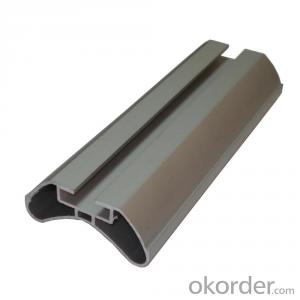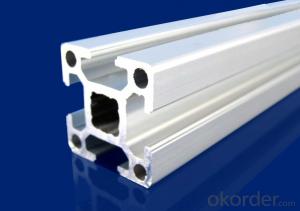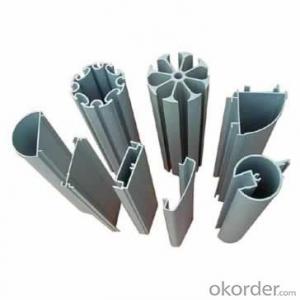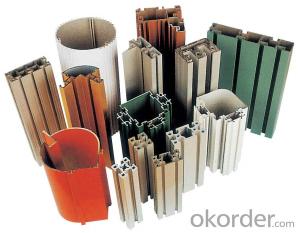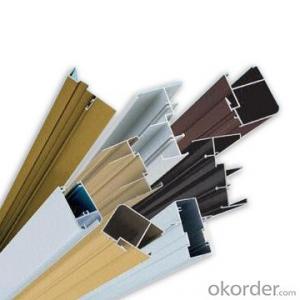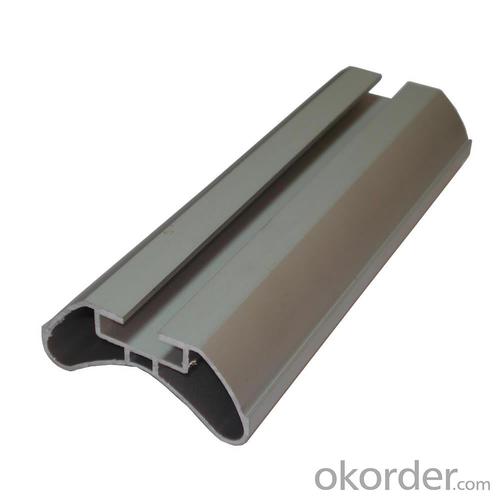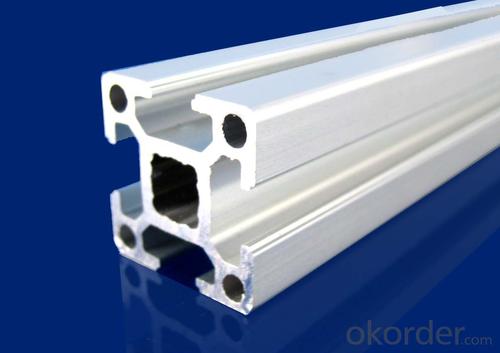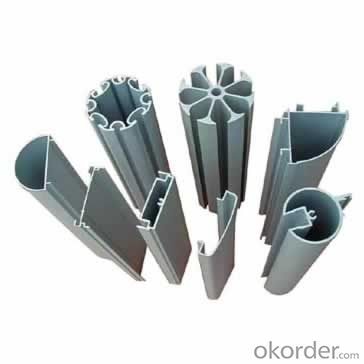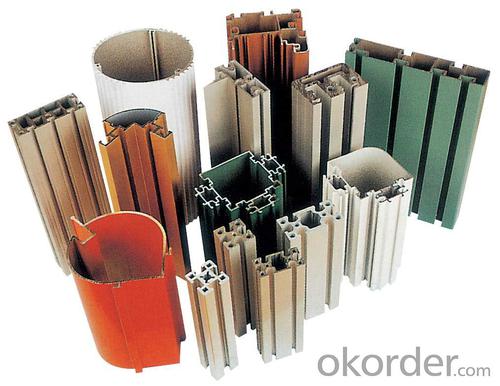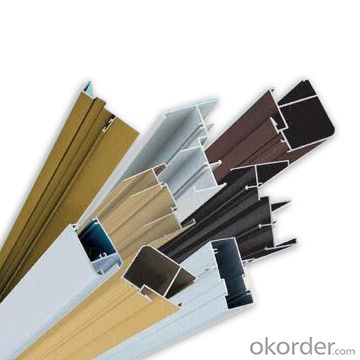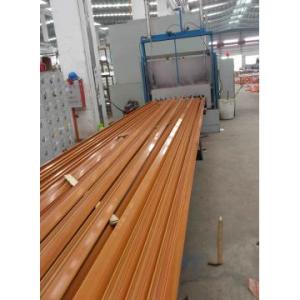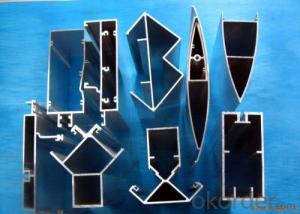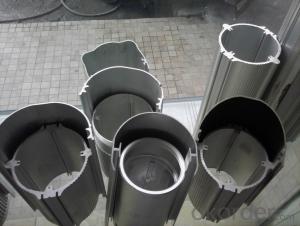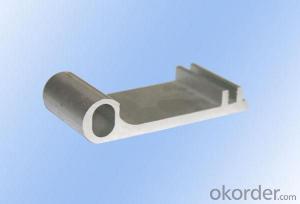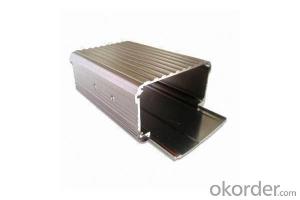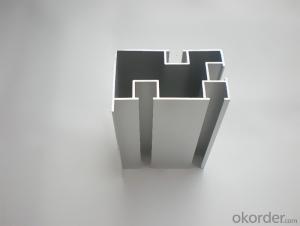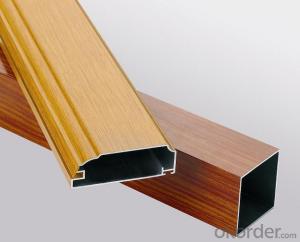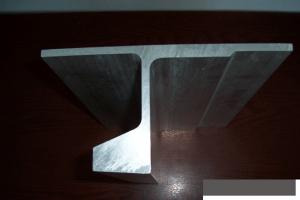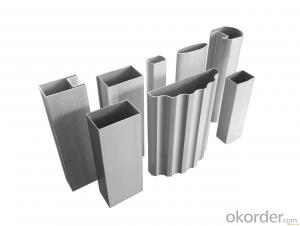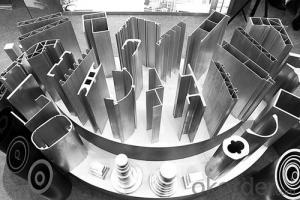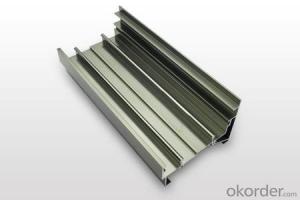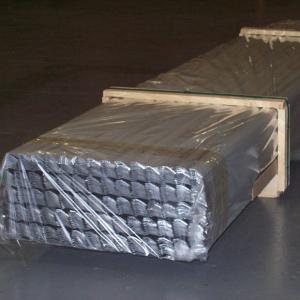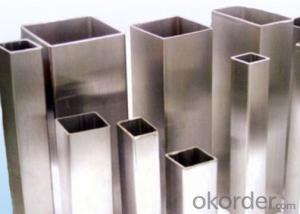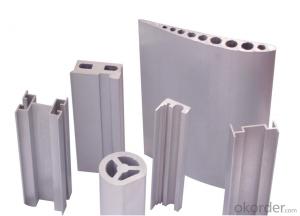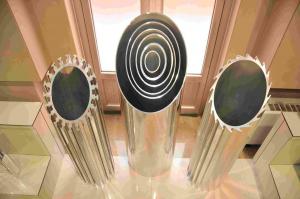Aluminum Strut Profiles 6061 Aluminum Profile Extrusion
- Loading Port:
- China Main Port
- Payment Terms:
- TT OR LC
- Min Order Qty:
- -
- Supply Capability:
- -
OKorder Service Pledge
OKorder Financial Service
You Might Also Like
Aluminium is a relatively soft, durable, lightweight, ductileand malleablemetalwith appearance ranging from silvery to dull gray, depending on the surfaceroughness. It is nonmagnetic and does not easily ignite. A fresh film ofaluminium serves as a good reflector (approximately 92%) of visible lightand an excellent reflector (as much as 98%) of medium and far infraredradiation. The yield strength of pure aluminium is 7–11 MPa,while aluminium alloys have yield strengths ranging from200 MPa to 600 MPa. Aluminium has about one-third the densityand stiffness of steel. It is easily machined,cast, drawn and extruded.
Aluminium alloys (or aluminum alloys; see spellingdifferences) are alloysin which aluminium(Al) is the predominant metal. The typical alloying elements are copper, magnesium,manganese,silicon,tin and zinc. There are twoprincipal classifications, namely casting alloys and wrought alloys, both of which are furthersubdivided into the categories heat-treatableand non-heat-treatable. About 85% of aluminium is used for wrought products,for example rolled plate, foils and extrusions.Cast aluminium alloys yield cost-effective products due to the low meltingpoint, although they generally have lower tensile strengthsthan wrought alloys. The most important cast aluminium alloy system is Al–Si,where the high levels of silicon (4.0–13%) contribute to give good castingcharacteristics. Aluminium alloys are widely used in engineering structures andcomponents where light weight or corrosion resistance is required
Features:
Material | Alloy 6063,6061,6005or according to customer’s choice |
Temper | T3, T4, T5, T6 |
Surface | Anodize, electrophoresis, powder coating, PVDF coating, wood grain painting, matted, etc. |
Length | Coating 6.5 meters, Anodizing 6.5 meters, Mill finish 5 meters |
Application | Industrial, electrical equipment(TV set, air conditioner, refrigerator, computer), decoration,construction, transportation |
Custom Made | We can package following with customer's request. |
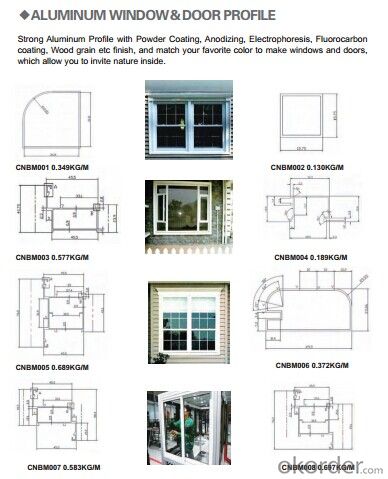
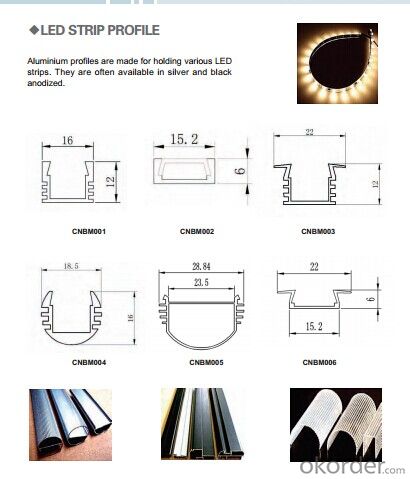
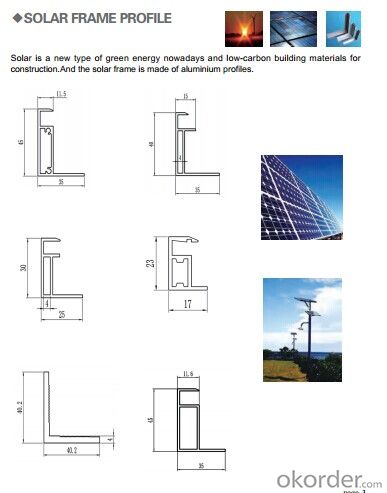
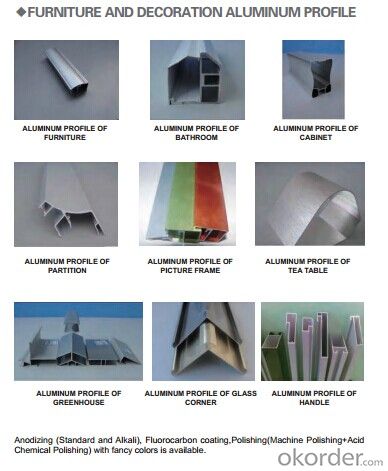
FAQ:
1. What is the form of payment?
Normally 30% TT, L/C at sight
2. Type of quotation?
FOB, CFR, CIF
3. Port of loading?
Shenzhen/Guangzhou port
4. Delivery time?
15-20 days after client’s deposit
- Q: What are the impact resistance properties of aluminum profiles?
- Aluminum profiles have excellent impact resistance properties due to their inherent strength and durability. They can withstand high impact forces without deforming or breaking, making them suitable for various applications where impact resistance is crucial, such as automotive, construction, and aerospace industries. Additionally, aluminum profiles can absorb and distribute impact energy effectively, minimizing the risk of damage or injury.
- Q: What cutting tool is better for cutting aluminum profile? Because this aluminum alloy material is used for radiator, there is 3mm thick sheet, it is standing up, and cutting to make it easy to deformation, which requires very sharp knives. After cutting for a period of time with a high speed steel tool, the tool is a little bit worn out, and the material starts to deform and the tool can no longer be used. Is it reasonable to use a corn cutter? Or it can be better solved with other tools or techniques.
- It is recommended to use carbide alloy milling cutters, and corn cutters are not recommended. Special aluminum processing of milling cutter front angle and screw angle are particularly sharp, and the drain trough is through special polishing processing, to chip removal has great influence, not easy to stick knife! It is also suggested that the use of emulsion cooling can greatly reduce the heat of cutting! If you are looking for surface finish, it is recommended to use cooling oil cooling!
- Q: Are aluminum profiles suitable for use in automotive suspension systems?
- Indeed, automotive suspension systems can benefit from the use of aluminum profiles. Aluminum, being both lightweight and strong, offers numerous advantages in suspension design. To begin with, the lightweight properties of aluminum profiles contribute to reducing the overall weight of the suspension system. This not only improves fuel efficiency but also enhances the vehicle's performance and handling. The decreased weight allows for faster acceleration, improved braking, and enhanced maneuverability. Moreover, aluminum profiles possess an exceptional strength-to-weight ratio, enabling them to withstand high loads and stresses while remaining lightweight. This makes them ideal for handling the dynamic loads experienced by suspension systems, such as bumps, vibrations, and impacts. Aluminum profiles can effectively absorb and distribute these loads, ensuring a smooth and comfortable ride for the vehicle occupants. Additionally, aluminum is highly resistant to corrosion, which is of utmost importance in automotive applications. Given that suspension systems are exposed to various environmental conditions, including moisture, salt, and road debris, the use of aluminum profiles minimizes the risk of corrosion. This, in turn, enhances the durability and longevity of the suspension components. Furthermore, aluminum profiles offer great versatility and can be easily shaped and formed into complex geometries required for suspension system components. This allows for greater design flexibility and optimization of performance. Aluminum profiles can be utilized in the manufacturing of various suspension components, including control arms, knuckles, and subframes. In conclusion, aluminum profiles are unquestionably suitable for use in automotive suspension systems. Their lightweight nature, high strength-to-weight ratio, corrosion resistance, and design flexibility make them an excellent choice for maximizing the performance, efficiency, and durability of suspension systems in vehicles.
- Q: Can aluminum profiles be utilized in creating distinctive architectural designs and styles?
- <p>Yes, aluminum profiles can be used to create unique architectural designs and styles. They are favored for their strength, durability, and versatility. Architects can manipulate aluminum to achieve a wide range of shapes and structures, from sleek modern designs to traditional styles with a contemporary twist. Aluminum's lightweight nature and resistance to corrosion make it an ideal material for both interior and exterior applications, allowing for creative freedom in architectural expression.</p>
- Q: Can aluminum profiles be used for shelving systems?
- Certainly, shelving systems can indeed utilize aluminum profiles. Renowned for their robustness, longevity, and adaptability, aluminum profiles prove to be an excellent selection for a wide range of uses, including shelving systems. One can effortlessly tailor and manufacture them to suit particular measurements and specifications, enabling the creation of shelving systems in various sizes and designs. Furthermore, owing to its lightweight yet sturdy nature, aluminum permits straightforward installation and upkeep. Additionally, it exhibits resistance against rust and corrosion, rendering it suitable for indoor as well as outdoor shelving systems. On the whole, aluminum profiles present a dependable and effective solution for shelving systems.
- Q: This question asks about the various techniques used to install aluminum profiles in construction projects.
- <p>There are several methods for installing aluminum profiles in construction: 1. Direct Fixing: Using screws or bolts directly into the aluminum profile. 2. Mortise and Tenon Joints: Joining profiles with a slot and a protruding part that fits into it. 3. Welding: Joining aluminum profiles using heat to melt and fuse them together. 4. Adhesive Bonding: Using adhesives to bond aluminum profiles together. 5. Mechanical Fasteners: Using nuts, bolts, and other fasteners to join profiles. 6. Clipping: Attaching profiles using clips or clamps. 7. Slot and Pin: A system where a pin fits into a slot in the profile. Each method has its advantages and is chosen based on the specific requirements of the construction project, such as load-bearing needs, aesthetic considerations, and ease of installation.</p>
- Q: Can aluminum profiles be used in the manufacturing of furniture?
- Furniture production can utilize aluminum profiles, which are versatile and lightweight materials. Aluminum possesses numerous advantages for furniture manufacturing, such as durability, corrosion resistance, and a high strength-to-weight ratio. Due to these properties, it is suitable for various furniture applications, including chairs, tables, shelving units, and frames. Moreover, aluminum profiles offer easy customization, enabling the creation of distinctive and contemporary designs. By incorporating aluminum into furniture manufacturing, sustainability is promoted as it is a recyclable material. In conclusion, aluminum profiles offer flexibility and durability to designers and manufacturers, rendering them a favored option in the furniture industry.
- Q: Explain the various methods used to connect aluminum profiles in construction.
- <p>In building construction, aluminum profiles can be joined together using several methods: 1. Mechanical fastening, which includes bolts, screws, and rivets. 2. Welding, which permanently fuses the profiles together using heat. 3. Adhesive bonding, which uses specialized adhesives to bond the profiles. 4. Clipping or snap-fit connections, which use spring-loaded clips or interlocking parts. 5. Mortise and tenon joints, where one profile has a projection that fits into a hole in another. 6. Socket and pin connections, where a pin is inserted into a socket on the profiles. These methods can be used individually or in combination, depending on the specific requirements of the construction project.</p>
- Q: This question asks about the various types of aluminum profiles that are utilized in the construction of exterior wall systems.
- <p>Aluminum profiles for exterior wall systems include several types: 1. <strong>Vertical and Horizontal Mullions</strong>: These are the main structural components that form the framework of the system. 2. <strong>Transoms and Muntins</strong>: These profiles divide the large glass panes into smaller sections, providing structural support and aesthetic appeal. 3. <strong>Cover Caps</strong>: Used to cover the joints and intersections of the profiles, enhancing the visual appearance and weatherproofing. 4. <strong>Sill Channels</strong>: Installed at the base of windows to direct water away from the building. 5. <strong>Head Channels</strong>: Positioned at the top of the window or door openings. 6. <strong>Jamb Liners</strong>: These are used to reinforce the sides of the openings. 7. <strong>Gaskets and Seals</strong>: Essential for weatherproofing and insulation. Each type serves a specific function in ensuring the stability, durability, and aesthetic of the exterior wall system.</p>
- Q: Are there any safety considerations when working with aluminum profiles?
- Yes, there are several safety considerations that should be taken into account when working with aluminum profiles. Firstly, it is important to wear appropriate personal protective equipment (PPE) such as gloves, safety glasses, and a dust mask when handling aluminum profiles. This is because working with aluminum profiles can generate fine metal shavings and dust, which can be harmful if inhaled or come into contact with the skin or eyes. In addition, it is important to ensure proper ventilation in the work area to minimize the accumulation of aluminum dust and fumes. This can be achieved by using exhaust fans or opening windows and doors to allow fresh air to circulate. When cutting or machining aluminum profiles, it is crucial to use the correct tools and techniques to prevent accidents or injuries. This includes using sharp blades or cutting tools specifically designed for aluminum, as using improper tools can lead to kickback or other hazards. Furthermore, it is important to handle aluminum profiles with care, as they can have sharp edges or corners that can cause cuts or injuries. Proper lifting techniques should be used to avoid strain or back injuries when moving or installing aluminum profiles. Lastly, it is important to be aware of the potential fire hazards associated with aluminum dust. Aluminum dust is highly flammable and can ignite if exposed to an ignition source, such as a spark or open flame. Therefore, it is important to maintain a clean work area and regularly remove any accumulated aluminum dust to minimize the risk of fire. Overall, by following these safety considerations and taking necessary precautions, the risks associated with working with aluminum profiles can be minimized, ensuring a safe working environment.
Send your message to us
Aluminum Strut Profiles 6061 Aluminum Profile Extrusion
- Loading Port:
- China Main Port
- Payment Terms:
- TT OR LC
- Min Order Qty:
- -
- Supply Capability:
- -
OKorder Service Pledge
OKorder Financial Service
Similar products
Hot products
Hot Searches
Related keywords
